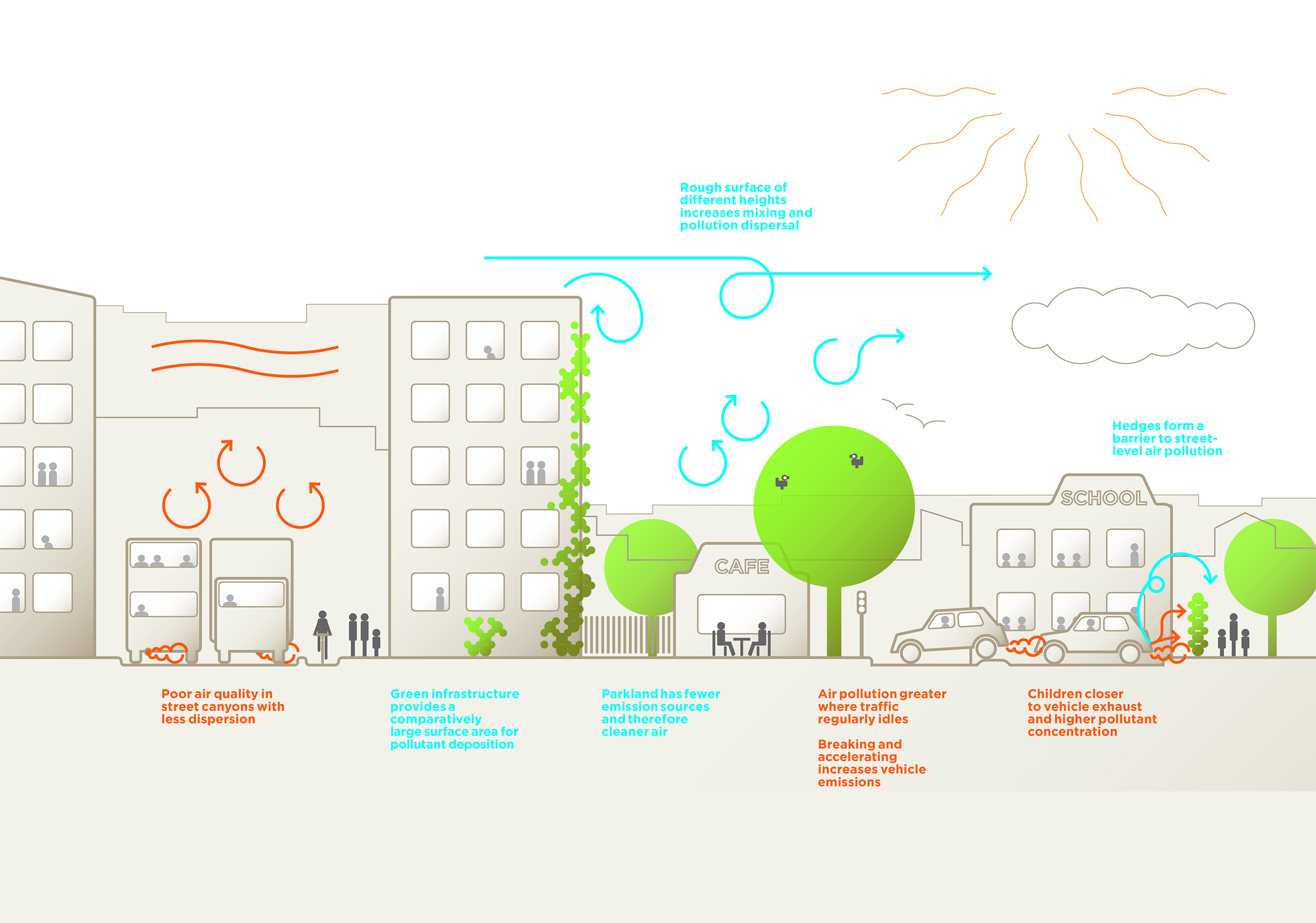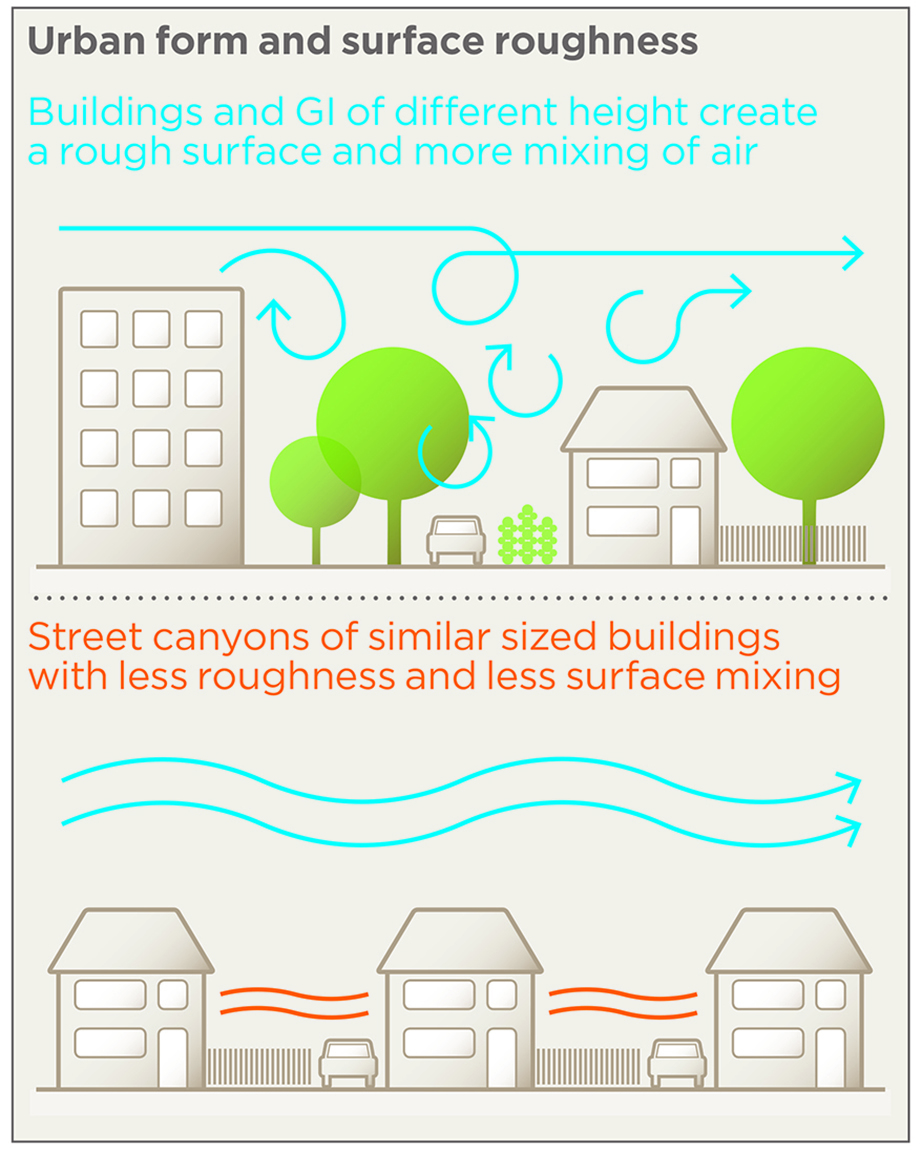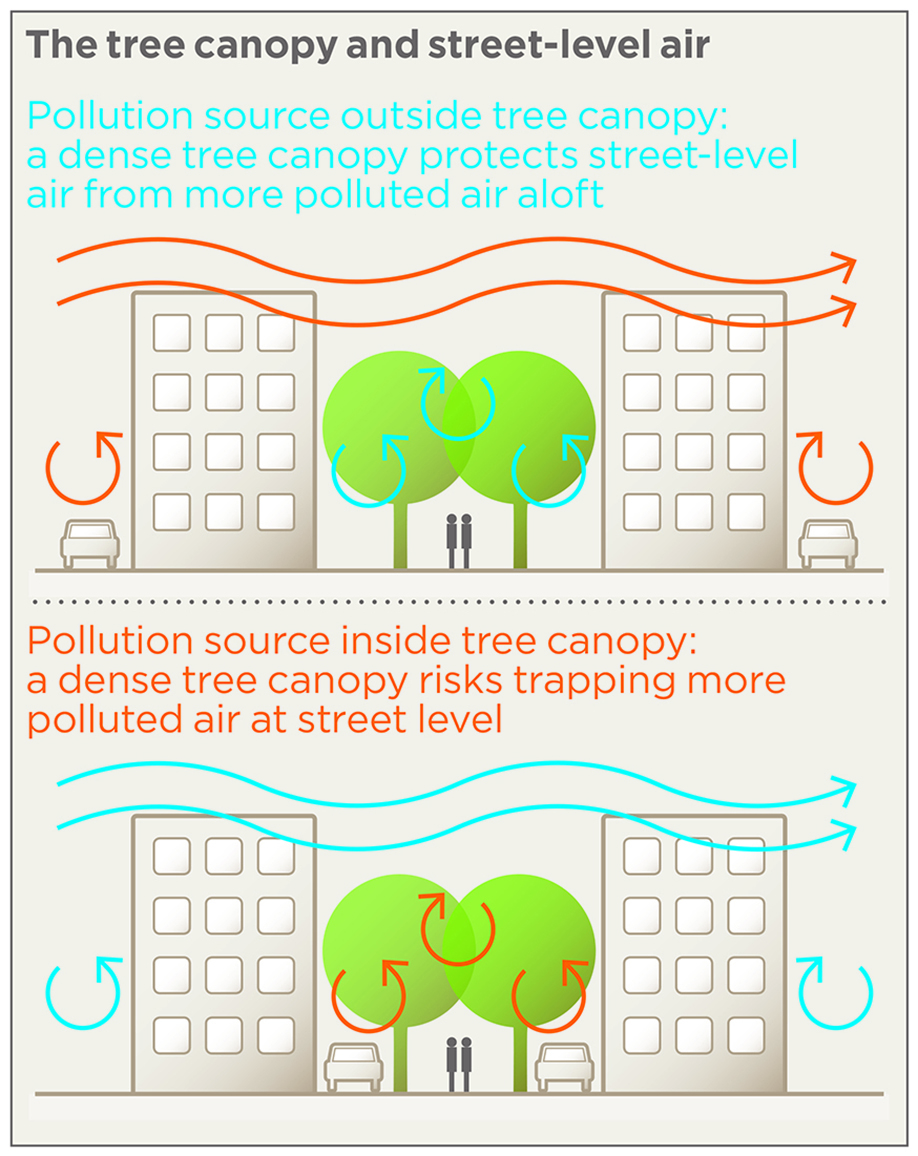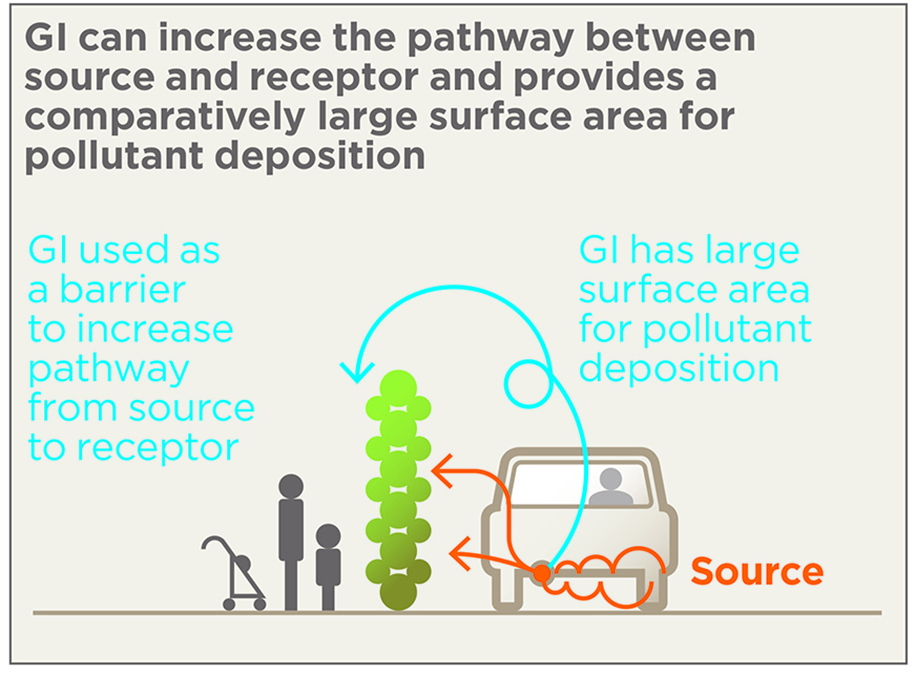environmental SCIENTIST | Right Tree • Right Place | March 2019
Emma Ferranti, James Levine and Rob MacKenzie explain the role of vegetation for air quality management in our cities.
‘Green infrastructure’ (let’s shorten that to ‘GI’ but remember we’re talking about trees, not Joes) refers to all vegetation in urban areas, including parks, private gardens, green roofs and walls, grass verges and street trees. GI is ‘infrastructure’ in the sense that it brings a multitude of environmental benefits to our towns and cities.1 Some of these benefits are at risk of being underestimated while we lack a means of measuring them, that is, of measuring the natural capital associated with the ecosystem services that GI provides.
Urban practitioners are familiar with the notion that GI provides space and connectivity for nature, providing and linking habitats for plants and animals and thereby increasing biodiversity. It is also widely understood that GI can increase urban resilience to extreme weather, such as heavy rainfall events and very hot summers, expected to increase in frequency as a result of climate change.2 As examples, sustainable urban drainage systems (SUDS) store rainwater and attenuate its release, reducing demands on mains drainage; and trees mitigate the urban heat island effect through the creation of cooler microclimates via the provision of shade and transpiration (the uptake of groundwater and the release of water vapour).
Steps are being taken to quantify these ecosystem services. The Construction Industry Research and Information Association has developed a freely available Benefits of SUDS Tool (B£ST). Meanwhile, a recent study by the Forestry Commission highlighted the monetary value of tree transpiration, estimating an annual saving in air conditioning costs across London ranging from £2.1–84 million.3 There are also economic benefits: attractive placemaking increases footfall and potential customer numbers increase, benefitting local businesses and stimulating the ‘business of serendipity’, thus fuelling greater productivity.
Many of the benefits of GI have a direct bearing on human health, translating into health costs saved and working days gained. For urban inhabitants, GI can provide space for recreation and physical activity, and confers benefits for mental health too, including: psychological relaxation, stress alleviation and increased social cohesion.4 Public Health England recently commented, ‘If green infrastructure was a pill, every GP in the country would be prescribing it’.5
GI also offers significant physical health benefits via improved air quality, but not as we perhaps expect. Pollutants are deposited to leaf surfaces, but the fraction of pollution removed by this mechanism in the urban environment is typically just a few percent, owing to the small scale of realistic planting schemes6 and the relatively slow rate of transfer of pollution particles and molecules to (leaf) surfaces. The value of GI for urban air quality lies in its ability, not to remove pollution, but rather to control its distribution by strategically enhancing (or reducing) its dispersion close to its source7. For instance, in an open-road environment and under the right wind conditions – blowing from vehicles towards pedestrians – a vegetation barrier can halve the concentrations of pollutants in its immediate wake.6 As explained below, GI can be of benefit, dis-benefit or of little consequence for air quality. However, used strategically, i.e. with the right vegetation in the right place, GI offers considerable benefits in terms of the public health impact of urban air pollution by altering the public’s exposure to it.
The University of Birmingham is developing a software platform with urban practitioners to enable them to predict quantitatively the impacts of a range of interventions on exposure, on a site-by-site basis. Meanwhile, as outlined below, certain interventions will reliably reduce exposure.
Urban air pollution
The World Health Organization identifies air pollution as the greatest environmental risk to human health:8 90 per cent of the world’s urban population live in cities exceeding its air quality guidelines, and outdoor air pollution claims roughly 3 million lives each year. In the UK alone, outdoor air pollution contributes to approximately 50,000 deaths each year,9 and road transport has been identified as the main source of directly emitted emissions in urban areas.10 Roadside air pollution often exceeds national air quality objectives and has been the subject of litigation against the UK government.11 In these reports, and in what follows, the key pollutants are microscopic particulate matter (PM) and nitrogen dioxide (NO2). However, there are some pollutants – notably ozone and secondary PM – where the relationship with emissions is not linear,12 but we do not consider those here.
 |
| Figure 1. The role of trees and other green infrastructure in urban air quality.13 (© Trees and Design Action Group Trust). |
Urban form (the size, shape and configuration of our built environment) affects the location and strength of road transport sources of pollution and, importantly, its subsequent dispersion (dispersion refers to the way that air dilutes pollutants and carries them away from their sources). Critically, the impact of road transport pollution on human health depends on the concentration of pollutants at point of exposure – in other words, not only the amount of pollution emitted at source but also how much it has dispersed en route to its human ‘receptors’. The total public health impact also depends on the number of people exposed, the length of time for which they are exposed, and their vulnerability; the very young and the elderly are particularly vulnerable, as are people with certain pre-existing medical conditions.
Through its impact on the emission and dispersion of pollution, and hence the extent of exposure, urban design has a significant bearing on the public health impacts of pollution emissions. Good urban design provides a tool with which to reduce these impacts and improve health outcomes (and health equality) via the application of three key concepts, listed here in order of priority:13
- Reduce emissions, particularly from road transport. This is by far the most effective way to reduce urban air pollution and improve public health outcomes.
- Extend the distance between sources of pollution and human receptors (this is called the source–receptor pathway). Pollutant concentration is highest close to the emissions source but decreases with distance, initially very quickly, as a result of mixing with cleaner ambient air. Increasing the dispersion of pollutants between source and receptor reduces the concentration at the point of exposure.
- Protect the most vulnerable people. Anyone can suffer negative health impacts from air pollution, but children under 14, adults over 65 and those with pre-existing health conditions, such as chronic obstructive pulmonary disease (COPD) or asthma, are most vulnerable.14
 |
| Figure 2. Green infrastructure can be used to create heterogeneous surfaces that stimulate the mixing, and hence dilution, of relatively polluted air at street level with relatively clean air above it.13 (© Trees and Design Action Group Trust). |
 |
| Figure 3. The effect of a dense avenue of trees in an urban canyon depends on whether the air at street level is cleaner or more polluted than the air above it. By reducing mixing between the two, a dense canopy on a quiet street protects relatively clean air at street level from the import of polluted air from above (top panel). On a busy street, however, a dense canopy risks trapping pollution at street level (bottom panel).13 (© Trees and Design Action Group Trust). |
 |
| Figure 4. Green infrastructure barrier to extend the distance between emissions source and receptor, and protect vulnerable people on the roadside.13 (© Trees and Design Action Group Trust). |
The world is becoming increasingly urbanised and the United Nations estimates that by 2050, 68 per cent of the global population will live in urban areas. It is imperative that our urban areas are resilient to extreme weather and future climatic change, and are healthy, liveable places for their inhabitants. The importance of GI in creating resilient urban environments is becoming acknowledged nationally and internationally. Cities are leading this green revolution: Birmingham is part of the international biophilic cities network,23 aspiring to place nature at the heart of all planning decisions; Greater Manchester aims to be the UK’s first zero-carbon city by 2038 and is planting a tree for every resident within a generation.24 In June 2019, London will become a National Park City making the city greener, wilder and healthier for its residents.
Emma Ferranti and James Levine are senior researchers at Birmingham Instistute of Forest Research (BIFoR) at the University of Birmingham. Rob MacKenzie is Professor of Atmospheric Science and Director of BIFoR. Ferranti holds NERC Knowledge Exchange (NE/N005325/1) and EPSRC Living With Environmental Change (EP/R007365/1) Fellowships; Levine and MacKenzie have NERC Innovation funding for GI4RAQ (NE/S00582X/1, NE/S00940X/1, NE/S013814/1). All authors contribute to GI work strand in WM-Air (NE/S003487/1).
REFERENCES
1. Forestry Commission. The Urban Forest. https://assets.publishing.service.gov.uk/government/uploads/system/uploa...
2. Met Office. UK Climate Projections 2018 https://www.metoffice.gov.uk/research/collaboration/ukcp/key-results (accessed 4 February 2019).
3. Moss, J.L., Doick, K.J., Smith, S. and Shahrestani, M. (2019) Influence of evaporative cooling by urban forests on cooling demand in cities. Urban Forestry & Urban Greening, 37, pp.65–73. https://doi.org/10.1016/j.ufug.2018.07.023
4. WHO Regional Office for Europe (2017) Urban green spaces and health: A review of impacts and effectiveness. http://www.euro.who.int/en/health-topics/environment-and-health/urban-he...
5. Presentation given by Dr Ann Marie Connolly , Deputy Director Health and Wellbeing, Public Health England at Trees, People and the Built Environment 3, 5–6 April 2017, University of Birmingham.
6. Air Quality Expert Group (2018) Impacts of Vegetation on Urban Air Pollution. Prepared for the Department for Environment, Food and Rural Affairs; Scottish Government; Welsh Government; and Department of the Environment in Northern Ireland. https://uk-air.defra.gov.uk/assets/documents/reports/cat09/1807251306_18...
7. Greater London Authority (2019), in consultation with the Birmingham Institute of Forest Research (University of Birmingham), the Global Centre for Clean Air Research (University of Surrey) and Transport for London, ‘Using Green Infrastructure to Protect People from Air Pollution’, freely available to download from https://www.london.gov.uk/WHAT-WE-DO/environment/environment-publication..., published online 04 April 2019.
8. World Health Organisation (2016) Ambient air pollution: A global assessment of exposure and burden of disease. http://www.who.int/phe/publications/air-pollution-global-assessment/en/
9. Landrigan, P.J., Fuller, R., Acosta, N.J., Adeyi, O., Arnold, R., Baldé, A.B., Bertollini, R., Bose-O’Reilly, S., Boufford, J.I., Breysse, P.N. and Chiles, T. (2018) The Lancet Commission on pollution and health. The Lancet, 391 (10119), pp.462–512. https://doi.org/10.1016/S0140-6736(17)32345-0
10. Department for Environment, Food and Rural Affairs. What are the causes of air pollution? https://uk-air.defra.gov.uk/assets/documents/What_are_the_causes_of_Air_...
11. Cuff, M. and Murray, J. (2018) ClientEarth wins third battle with government over air quality plan. Business Green 21 February, 2018. www.businessgreen.com/bg/news/3027090/clientearth-wins-thirdbattle-with-... (accessed 4 February 2019).
12. Harrison, R.M. (ed) (2013) Pollution: Causes, Effects and Control. 5th edn. Cambridge: RSC Publishing.
13. Ferranti, E.J.S., MacKenzie, A. R., Ashworth, K. and Hewitt, C.N. (2019) First Steps in Air Quality for Built Environment Practitioners. Technical Report. University of Birmingham and Tree and Design Action Group (TDAG). http://epapers.bham.ac.uk/3069/
14. National Institute for Health and Care Excellence (2017) Air pollution: outdoor air quality and health. London: Department of Health. https://www.nice.org.uk/guidance/ng70/resources/air-pollutionoutdoor-air...
15. Barnes, M.J., Brade, T.K., Mackenzie, A.R., Whyatt, J.D., Carruthers, D.J., Stocker, J., Cai, X. and Hewitt, C.N. (2014) Spatially varying surface roughness and ground-level air quality in an operational dispersion model. Environmental Pollution, 185, pp.44–51.
16. Jeanjean, A.P.R., Hinchliffe, G., McMullan, W.A., Monks, P.S. and Leigh, R.J. (2015) A CFD study on the effectiveness of trees to disperse road traffic emissions at a city scale. Atmospheric Environment. 120, pp.1–14.
17. Hewitt, C.N., Ashworth, K. and MacKenzie, A.R., 2019. Using green infrastructure to improve urban air quality (GI4AQ). Ambio, pp.1-12.
18. Donovan, R.G., Stewart, H.E., Owen, S.M., MacKenzie, A.R. and Hewitt, C.N. (2005) Development and application of an urban tree air quality score for photochemical pollution episodes using the Birmingham, United Kingdom, area as a case study. Environmental Science & Technology, 39 (17), pp.6730–6738. https://pubs.acs.org/doi/pdf/10.1021/es050581y
19. Hirons, A.D. and Sjöman, H. (2018) Tree Species Selection for Green Infrastructure: A Guide for Specifiers. http://www.tdag.org.uk/species-selection-for-green-infrastructure.html
20. Weerakkody, U., Dover, J.W., Mitchell, P., and Reiling, K. (2019) Topographical structures in planting design of living walls affect their ability to immobilise traffic-based particulate matter. Science of The Total Environment, 660, pp.644–649. https://doi.org/10.1016/j.scitotenv.2018.12.292
21. Pugh, T. A., MacKenzie, A. R., Whyatt, J. D., and Hewitt, C. N. (2012) Effectiveness of green infrastructure for improvement of air quality in urban street canyons. Environmental Science & Technology, 46 (14), pp.7692–7699. https://pubs.acs.org/doi/10.1021/es300826w
22. Lucy Larcom (1824–93) Plant a Tree. https://www.poetrynook.com/poem/plant-tree
23. Biophilic Cities. http://biophiliccities.org/
24. Manchester City of Trees. http://www.cityoftrees.org.uk/





